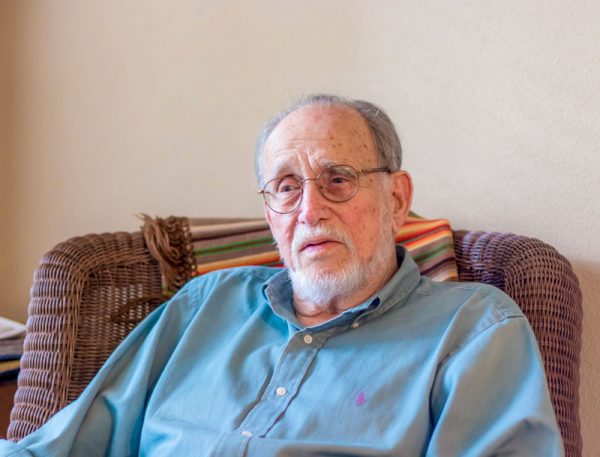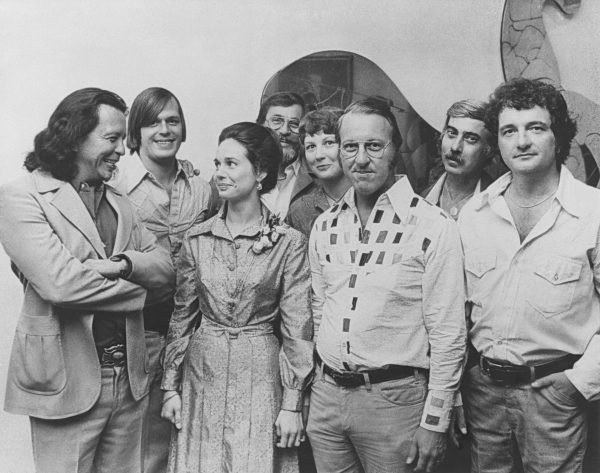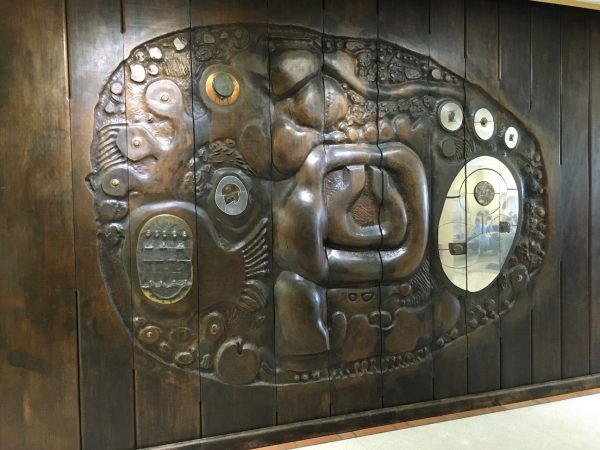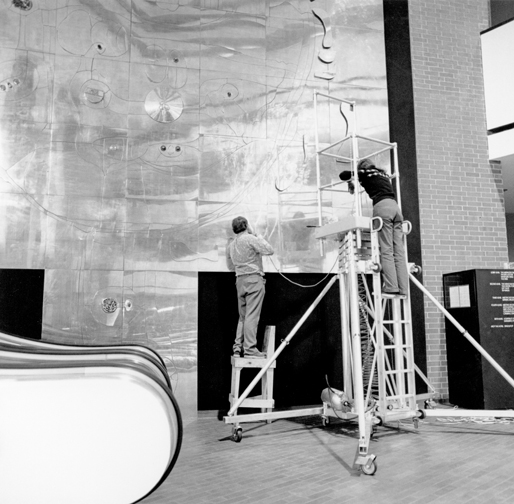
Charles Pebworth. Image: Postcards Magazine
The artist Charles Pebworth, a Native American who for years was an instrumental member of Houston and Huntsville’s art communities, died earlier this year following complications from a fall. He was 92. He is survived by his wife, Nona, and his four children and their families.
When he was growing up in the 1930s and 40s in Pawhuska, Oklahoma, Mr. Pebworth didn’t have much of an inlet to art. In a 2006 interview with Sally Reynolds, he confided that in those times, though he remembers making woodblock and linoleum block prints, “high school boys didn’t [do art].” Instead, Mr. Pebworth left high school early and opted to serve in WWII. After a long process of forging his parents’ signatures (since he was only sixteen when he tried to join the Navy), getting found out, and then entering the Air Force, Mr. Pebworth ultimately found himself as a paratrooper in the Army.
Once the war ended, Mr. Pebworth attended school using his GI bill. After a short stint studying forestry at Colorado A&M, Mr. Pebworth followed a friend of his to the Art Center school in Los Angeles to study art. From there, he went on to Pasadena City College, and then in 1948 came back to Texas and enrolled as a painter in Baylor University’s art program. Two years later, Mr. Pebworth again put his education on hold and volunteered for the Korean War.
Once he returned from combat in 1951, Mr. Pebworth enrolled in the University of Oklahoma’s art department. He soon met his wife, Nona, and they eloped to Houston, where Mr. Pebworth eventually received his undergraduate degree from the University of Houston. After working at the Foley’s department store doing displays, Mr. Pebworth left Houston for two years to earn his MFA from Louisiana State University. Then, a tenured teaching job at Sam Houston State University in Huntsville brought him back to Texas.

Opening of the Moody Gallery, 1975. From left to right: Fritz Scholder, Lucas Johnson, Betty Moody, Charles Pebworth, Victoria Andrews, Arthur Turner, Stanley Lea, Lamar Briggs
Throughout his 36 years as a professor (he worked at the university from 1957-1993), Mr. Pebworth served as a mentor for many artists coming through SHSU’s program. Artist James Surls, who studied under Mr. Pebworth, told Glasstire how he learned from Mr. Pebworth’s approach to teaching:
“In the old days, the teacher was really tough: they would throw your work down and break it and say it was the worst thing ever – part of their process was to beat you up. Mr. Pebworth was the opposite of that. Mr. Pebworth’s goal was to elevate. He never tried to bring me down, he never tried to stop me, he never tried to put me in my place. He was an extraordinarily giving man. He gave his students a sense of respect for what they were doing. He had this inherent ability to pick out the thing that was best in you, and to elevate it. And that’s why his students loved him. That’s why all of us loved him. He had a gift. He certainly gifted me. He was my doorway into the art world.”
Another of Mr. Pebworth’s students, artist Andy Don Emmons, told Glasstire that as a professor Mr. Pebworth “taught [him] a good work ethic, forced [him] to produce, and gave [him] inspiration and guidance.” Others who knew Mr. Pebworth personally and professionally remembered him for his approachability and kindness.
In addition to teaching at SHSU, Mr. Pebworth was commissioned to create public artworks across Houston, and showed in some of the city’s most influential early galleries, including Bute Gallery, DuBose Gallery, Moody Gallery, and Harris Gallery. For his public artworks, Mr. Pebworth had a unique talent of creating metal relief pieces that sat nicely with most architectural styles — Betty Moody, who told Glasstire that her gallery “probably wouldn’t be here today if it wasn’t for Charles Pebworth in those early years,” called Mr. Pebworth “an architect’s dream.” One of Mr. Pebworth’s most iconic public works, and perhaps a piece that made the biggest impact on the city of Houston, is a large-scale metal relief commissioned by the Hyatt Regency downtown.
In addition to creating metal reliefs, Mr. Pebworth also made paintings, watercolors, and sculptures out of marble and wood. Many of his works include references to the natural world and Native American imagery, which comes out of his experience as a member of the Choctaw tribe, and his upbringing on an Osage reservation.
Though he didn’t know Mr. Pebworth personally, Randy Tibbits, who is one of the founding members of the Houston Earlier Texas Art Group, told Glasstire about his relationship with Mr. Pebworth’s work:
“What exuberant, distinctive art it is. You know a Pebworth piece from across the room — or across the vast lobby, in some cases, since many of his mixed media wall works — in metals, woods, stones — literally filled lobby walls in buildings around Houston and beyond. But every Pebworth work, even the pill-box sized pieces humble collectors in small spaces have room for, is unmistakably his.
Though I didn’t know him as a teacher, his contribution in helping younger artists find their own voices – for many years at Sam Houston State University in Huntsville — will also live on as a continuing legacy.”

Charles Pebworth, Untitled, Mahogany and metal, 1988. Installed at the Newton Grisham Library, Sam Houston State University
Years after retiring from his position at SHSU, Mr. Pebworth and his wife moved to Fayetteville, Arkansas to be closer to family and the cabin they built in the Ozark Mountains.” He never stopped working, and created art up until his death.




3 comments
He was one of the first Houston artists I knew about growing up. My parents owned his work, and I always appreciated his workmanship and signature style.
I was very sorry to hear that Charles Pebworth has passed away. In the early 70’s I remember seeing a few works by Mr. Pebworth for sale in the gallery, but I do not know the specific reason they were there. I do remember them as being quite magical and different than anything I had seen up to that time. I was in awe of how well-crafted they were. They seemed like doorways to some other dimension, decorated with symbols, to my mind, representing an alien or lost language.
In the early 90’s, we started exhibiting in The Art Show in NYC. During that time, we would occasionally be consigned objects that Mr. Pebworth had created from estates. Often, these would be wooden boxes that would open to reveal his mystic iconography of polished interlocking metal shapes. They were always sold opening night to collectors who had no idea who he was.
Last year, I attended the Texas Association of Museums meeting that was held at the Hyatt Regency in Houston. I checked in and was impressed with the lobby spaces that soared upward in a triangular shape. It was not until the next day that I looked around the lower level and discovered Mr. Pebworth’s monumental installation above the escalators. I knew instantly who had done it and spent the next 10 minutes going up and down the escalator enjoying its lyrical undulations.
I have always thought that Pebworth was a Texas treasure and after reading Mr. Zech’s article, especially James Surls’ quote, I know that to be true. He is one of the Early Texas artists I wish I had made the effort to get to know personally. I hope one of our major Texas Museums will honor his memory with a retrospective as I believe he is deserving. Thank you for the pleasurable moments you have provided me over the years.
In addition to being an artist of the highest talent and work ethic, besides being a wonderful teacher and mentor, he was a great and dear friend. We miss him very much.